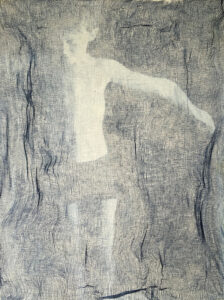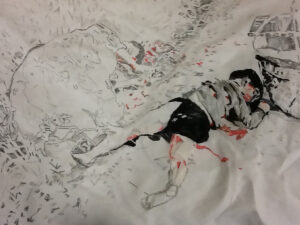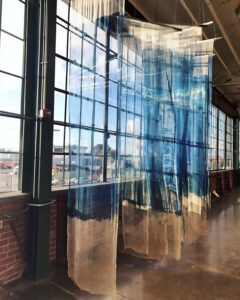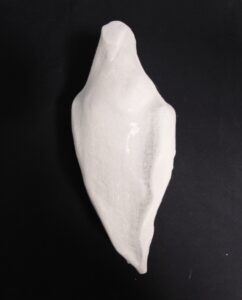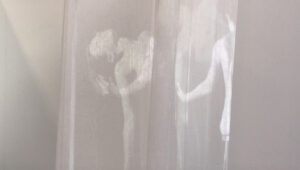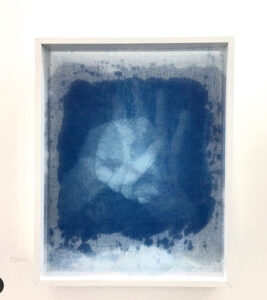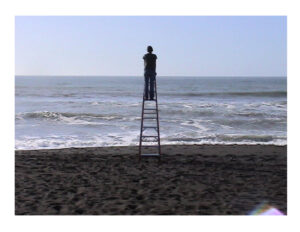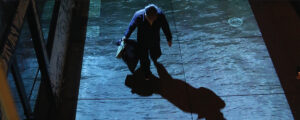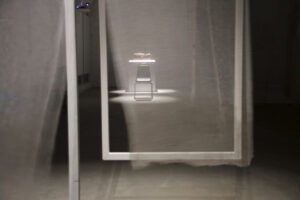Summer Mei Ling Lee was born in the San Francisco Bay Area and shares time in San Francisco and Chicago. She graduated from Stanford University in 1997 and received her MFA in painting and sculpture from the San Francisco Art Institute in 2011.
A multi-disciplinary artist, Summer has recently been responding creatively to site and situation, working for years with Abby Chen and most recently with Candace Huey of re.riddle. Both curators have given Summer artistic opportunities to create process-based works and performances, embracing risk-taking and collaboration. Through research and discovery, she sets the conditions for art to enter. Themes of absence and presence, the relationship between artist and collaborator, and the relationship to the untranslatable have emerged in recent projects.
She also maintains a studio practice making objects and paintings. Two of her small bird sculptures are currently on display in a group show at 41 Ross, entitled Body Electric, by re.riddle and supported by the Chinese Culture Center of San Francisco. In August, two defaced dollar bills with early Renaissance Marcovaldo wings are included in a group show at Saatchi Art Gallery in London, “Cash is King II.” In December, re.riddle will bring Summer’s work to Hong Kong for a salon exhibition with affiliated programming.
Recent exhibitions include Minnesota Street Project (San Francisco); Marqueyssac, France; Untitled Art Fair “Monuments,” Chinese Culture Center of San Francisco, SCOPE Miami Beach (Art Basel), Berliner Liste, Italian Institute of Culture, San Francisco Arts Commission, Yerba Buena Center for the Arts (San Francisco), Southern Exposure (San Francisco), Woman-Made Gallery (Chicago, IL) and Fei Contemporary Art Center (Shanghai).
Her recent public art installation “Liminal Space/Crossings” funded by the NEA, was a finalist for the Robert E. Gard Award and the subject of a documentary film screened at CAAMfest 2018. Lee was recently interviewed and featured in Hyperallergic magazine for her installation “Requiem” which pays homage to Hong Kong’s Tung Wah Hospital’s role in the repatriation of Chinese immigrant bones to China. Lee’s research of the bone boxes in Hong Kong and Taishan, China is featured in a documentary film, Requiem. Her work is in the permanent collection of He Xiangning Museum in Shenzhen, China.
How did you find yourself in the arts?
The beginning of my art practice can be described as a slow coming-out process. After beginning a career in social work, first with immigrant women escaping domestic violence and trafficking, and then with severely mentally-ill incarcerated adults, I started taking painting and landscaping classes for stress relief, and it turned into the only thing that felt right to me.
I will never forget when my UC Berkeley Extension Painting professor Eva Bovenzi stopped me as we were leaving the Anselm Kiefer exhibition at SFMOMA. I had told her how much I was inspired by Kiefer but that I didn’t think I had what it takes to make art, or some other sort of annoying doubt. With a sigh of scorn and impatience, she said, “Summer, you are an artist!” I remember walking silently back to my car, feeling both liberated and burdened by her pronouncement.
I feel very much that art-making, and even its career component, has chosen me. I try very hard to comply with its high standards and rigor, to the opportunities that have opened themselves to me, to serve as best I can. And I am always doubtful and feeling very much an eternal student of it all, with the haunting feeling it could end at anytime.
Who has been an influence in your career?
There are innumerous angels (and the rare demon) who have personally influenced my career. I have had the honor and fortuitousness to be supported by incredibly bright and gifted people — way too many to list here. But I would be remiss to not call out Eva Bovenzi for bringing me out into the art world with her own erudition and emphasis on aesthetic formality and spirituality.
Also, Pegan Brooke for her protection and advice, for her undying commitment to the luminous in art, in connecting art and nature and poetics.
Dewey Crumpler for running into me in the middle of the street once right after I had failed my midterm review in art school. Without introduction or any cursory formalities, he shook his hand at me with anger and passion, saying, “Never let them stop you from making art.”
Leigh Hyams who saw every disingenuous and lazy brushstroke in my paintings, sternly consoling me when I was crying at the limits of my own painting, that only artists understood this crying.
Abby Chen, who took a leap of faith of her own career by giving me my first important opportunities to exhibit, each time gifting me absolute freedom and encouraging risk-taking. Abby and I have many a phone call in the dark night to remind each other that in the dealings and seductions of the art world, we must never forget it is all about art.
My mentor Takeyoshi Nishiuchi, a scholar of zen and German Continental philosophy, for illuminating a North star of philosophy and ethics underlying art-making: that being underlies the aesthetic moment, how truly gratuitous art is, and that at the bottom of great doubt is an awakening. He had the courage to teach in art school that art criticism and theory has no rigour nor proof, and is only honest when it declares itself as “private, passionate experience seeking to persuade.”
Candace Huey, of re.riddle, who with her grace and sharp talents works tirelessly to promote my work and find opportunities for exhibiting all over the world — just because she believes in artists. Despite what can be transactional and grueling in art business, she maintains a tender heart for aesthetic moments and the connective energy that art brings. Both she and Abby have protected me from the harshness of the art world that if direct and unmediated could numb the desire to be creative.
I have the gift of generous friends, pen pals, and collaborators who resonate to similar aesthetics, keeping me less alone in what can be lethally lonely work. Laura Boles Faw and I have a generative collaborative practice where together we reach ideas and forms we would not have on our own. We also provide emotional support to each other as we move through the challenges and dilemmas facing working artists.
Nathan Filbert, Caroline Dufour, Sara Boffito, JiaJing Liu, Alice Bach, Sofia Villena-Araya, Marina Pugliese — all gifted comrades in art and poets of my heart, who send me timely and sustaining poems, writings, artworks, adventures and insights, and reflect back my work to me so I can grow it. I could keep going, but I will stop there and won’t even broach the list of artists and writers who have impacted me but whom I’ve never met.
What do you do when you hit a creative block?
It has been a long while since I’ve experienced a creative block, but generally I am of the mind that they appear when my own personal growth has been shunted off or that I am confronted with the necessity to go somewhere in my work or research that I am resistant to going. Or being blindsided by undermining criticism and needing time to shake it off. And recovery almost always boils down to being more expansively okay with uncertainty and failure. Then the delight of making is unfurled again.
How do you define success?
Success in art is just maintaining an art practice. To remain creative and making art is a form of resistance.
As for making successful work, I still feel I am a failure in the face of the utter freedom and discovery of the wayfaring that the best art necessitates, and I hope that before the end of my life I have achieved some work that asked deeply of me and I dared to answer it. I will know it when I look at the work and all my previous beliefs that brought me to that moment are suspended, and there are no words to translate the work, or even that moment, and I am left in tears. It will be a work that has brought me home to where I have not yet been.
I have experienced this in front of some master artworks and performances, or when arriving to an ancient pilgrimage site, but also in the intimacy of a poem or a humbly carved prehistoric bone — or in a poignant, personal interaction that alights and then is long gone. All of these instances remind me of my humanity — its fragility but also its dignity.
And when I gather myself back again, I want everyone I love to experience what I just had experienced. Maybe this is the impulse of the artist.
What advice would you give to your younger self?
I’m still trying to coach myself on this, put best by George Steiner: Gamble on welcome.
What legacy do you hope your work communicates?
I don’t care much for legacy or messaging, and I have only begrudgingly answered these questions thus far in my admiration for the your art editor, Amy Kisch.
For one thing, when I concern myself in my practice, primeval doubt and fear flood in and paralyze me. But also, when an artist talks too much, they destroy the conditions in which enabled the art to enter.
Often the best art is way ahead of the artist herself, and I feel there is way too much emphasis on the biographies or identities behind the maker, way too much interpretation and translation that overwhelms the primacy of the aesthetic experience that an artwork presents. We forget to gamble on the welcome that each artwork beseeches, instead wanting the certainty of contextualization and mediation from those whose professions are built on works that are easily translated or a boost to their own self-congealment or scholarship. Artwork made for and by this interpretive authority or trendy scholarship, or even political messaging, is dead on arrival for me, containing no life force of creation and otherwiseness from which art and beauty really derive the power to move us.
Of course, all artists have their own particularities and style, and even self-subsistence. But the goal is, as Celan describes, to go with Art into my very self-most straits and set myself free.
Ha ha! I guess I do have a message! Forget it.
Explore more of Summer’s work at www.summerleeart.com


